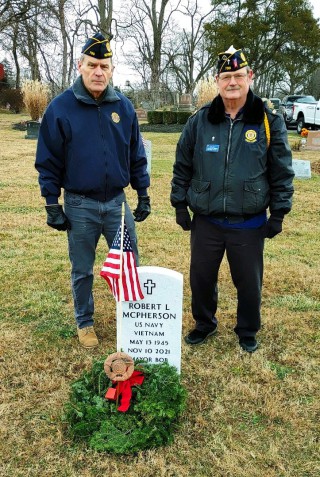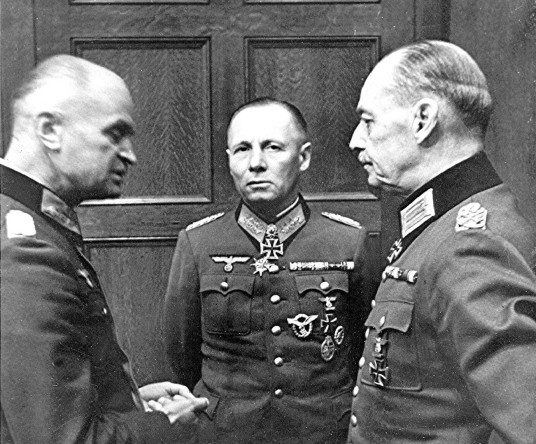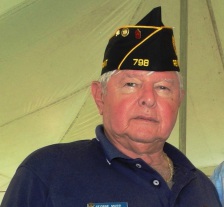DISTRICT WINTER CONFERENCE
The 12th District Council Winter Conference will be held on Sunday, January 8th, at 1300 hrs. at Paschall Post 164, 3363 McDowell Rd., Grove City.. For details, contact the district executive secretary, Steve Ebersole.
WREATHS ACROSS AMERICA, REYNOLDSBURG
At noon on Saturday, December 17th, a Wreaths Across America ceremony was held at Silent Home cemetery on Lancaster Avenue, in Reynoldsburg, Ohio, in observance of National Wreaths Across America Day. The ceremony was conducted by the local Civil Air Patrol squadron under the command of Lt. Elizabeth Saunders, and by officers of Reynoldsburg Post 798.
Wreaths were set on stands to honor each of the military services. Wreaths were also laid at each of the 208 veterans graves there,
including that of Mrs. Josephine Doney. The “Poppy Lady,” she was one of the first American Legion Auxiliary members in 1919, and she is credited as the originator of the American Legion poppy
program in 1920.
The officers of Post 798 were also deeply honored to commemorate and pay respects to the grave of a good friend, Navy veteran Robert McPherson. Bob was Mayor of Reynoldsburg from 1988 to 2008, and 1 VC of Post 798 from 2010 to 2020.
Shown in the photo below at his grave (l-r): 2 VC Jerry Schultz and Post Chaplain Carl Bradley. Also participating in the ceremony was Mindy Margaritis, wife of post adjutant Pete Margaritis.
OUT OF PRINT BOOK COMPILED BY OUR POST 798 ADJUTANT DETAILS HISTORY OF THE 12TH DISTRICT COUNCIL
In early March, 2019, a new book detailing the history of the American Legion Ohio 12th District Council was released. Entitled Buckeye
Veterans Centennial and compiled by our Post 798's Commander, Pete Margaritis (who is also the district historian), it chronicles the district’s development from 1919 to 2019.
12th District Council has in various configurations existed in Central Ohio for the last century. During those years, the many officers who
have served in it have striven hard to maintain and pursue the basic ideals of The American Legion, centered on our four pillars. Those thousands of men and women who are or were once part of this
proud organization have endeavored to strengthen and encourage it through their plans and activities. Throughout the years, they have created a rich tradition of service and commitment to the
Columbus area, especially to our veterans, our children, and community members who have dwelled in that area. Hundreds of thousands of hours of dedicated hard work have been freely given to
further those American Legion elements decided upon a century ago.
At times it has not been easy. Often serious roadblocks and issues challenged their efforts. Still, the 12th District Council persevered,
and today, well into the 21st Century, it still stands as a pillar to the community, as well as a distinguished honorable instrument of progress, a formidable presence, and a dedicated veteran
ally.
The book is currently out of print, but can be purchased through the 12th District Council for only
$15.00.
Contact the district office Thurs. from 0900 to 1300 hrs. at (614) 224-2900.
By the way, author Margaritis will autograph your copy for free.
GOING PAPERBACK
WAR MEMOIRS CO-WRITTEN BY POST HISTORIAN CONTINUE GETTING
GREAT REVIEWS
On August 2, 2017 a book co-written by Post 798's Commander, Pete Margaritis was released. Entitled Twenty-Two on Peleliu, it chronicles the remarkable World War II memoirs of an “Old Breed” Marine. The book depicts the very unusual life of a recently passed local veteran celebrity, George Peto of Columbus, Ohio, as told to the post commander, who is a prominent military author. In a collaborative effort recorded through 14 months of interviews, George recalled in detail to Cdr. Margaritis the exciting elements of his fascinating life.
In February, 2021, the book was re-released as a paperback. It can be purchased online at
any book outlet (Amazon, Barnes and Noble, etc.) or directly from the publisher, Casemate Publishing (See link)
https://www.casematepublishers.com/subject-categories/world-war-ii/pacific-theater/twenty-two-on-peleliu.html#.X_OYAmOSm70
Growing up in the Great Depression, the adventures of this happy-go-lucky kid, like an early day Forrest Gump, touched on so many unique facets of American history in the 20th Century. From gazing up at early dirigibles in Akron, Ohio during the Great Depression, to fishing and trapping on the Erie Canal not far from a gangster’s hideout, to working in the CCC out West. And his experiences in World War II as a forward observer for a heavy mortar team were even more memorable as he fought in four famous Pacific campaigns with an elite unit: The First Marines. Even after the war, George seldom had a dull moment, once fighting for what he believed right up to the Supreme Court (and he WON). Yes, George Peto was an extraordinary individual and lived a life more exciting than any four normal individuals. This is the story of a true Marine.
The book, published by Casemate, is available through any major book outlet, including Amazon, Barnes & Noble, and Google
Books.
By the way, Cdr. Margaritis will autograph your copy for free.
If you want to read an interesting interview Casemate Publishing did with our post commander/author, follow
this link:
https://thecasemateblog.wordpress.com/2017/08/11/meet-peter-margaritis-co-author-of-twenty-two-on-peleliu/
(Below: Sgt. George Peto showing Cdr. Margaritis photos
of him in his Thirties. Taken August 9th, 2015.)
BOOK WRITTEN BY POST ADJUTANT DETAILING PELELIU CAMPAIGN
In November 2018, another book on military history written by Post 798's Commander, Pete Margaritis was released. Entitled Landing in Hell, it chronicles the Peleliu invasion in World War II.
On September 15, 1944, with the Allied winning the war, the United States invaded a tiny lobster claw-shaped island named Peleliu, only 450
miles southeast of the Philippines and 650 miles north of New Guinea. The island group lay right in the path of the main line of the American advance eastward. Bypassing them would leave a
communications and logistical threat to their left flank. The Pacific High Command believed that taking Peleliu was needed as a prelude to General Douglas MacArthur’s long-awaited liberation of the
Philippines.
If Peleliu were taken, it could become a major airbase from which the Americans could mount massive bomber campaigns against the Philippines and eventually against Japanese home islands.
The main amphibious assault would be made by the famed First Marine Division under Maj.-Gen. William Rupertus. Confident in his men and his plan, he was sure this operation would be over quickly, and
resistance would be initially moderate but brief. He boasted that they would be victorious in just three days. Allied planners agreed, convinced that the landing would be fairly easy, that the
Japanese defending the island were relatively weak and unprepared, and that it would all be over in just a few days.
They were drastically wrong on all counts.
The Peleliu campaign took two and a half long months of hard fighting. The First Marine Division sustained terrific losses in fierce combat, each regiment averaging over 50% casualties―the highest
unit losses in Marine Corps history.
This book analyzes in detail the many things that went wrong to make these casualties so excessive, and in doing so, correct several earlier accounts of the campaign.
The book, published by Casemate, is available through any major book outlet, including Amazon, Barnes & Noble, and Google Books.
By the way, Cdr. Margaritis will autograph your copy for free.
Other books written by the commander include:
- Rommel's Fateful Trip Home: June 4th to June 6th, 1944
- Crossroads at Margival: Hitler's Last Conference in France, June 17, 1944
- Bust Eisenhower: The Message That Almost Ruined D-Day.
EXHAUSTIVE WORK ON D-DAY
In June 2019, on the 75th anniversary of the Normandy landings, another military history written by Post 798's Commander, Pete Margaritis was released. Entitled Countdown to D-Day: The German Perspective, it is an accurate, exciting diary-like chronicle of the day-to-day machinations of the German generals preparing to meet the enemy in the West. Starting in December, 1943, it delineates each day's activities, clear up through D-Day...
In December 1943, as the Allies plan to invade Fortress Europe, Generalfeldmarschal Erwin Rommel is appointed General Inspector in the Western Theatre. His mission: to assess the German defenses against an invasion. What he finds disgusts him. The famed Atlantikwall is just a paper tiger, woefully unprepared for the forces massing across the English Channel. So his task—to turn back the Allied invasion—already seems hopeless. He sets off with his army group staff to try to do the impossible before the enemy storm hits them.
His superior, crusty old Generalfeldmarschal Gerd von Rundstedt, a legend in Germany, had led the Reich to
victory after victory in the early years of the war. Now though, he is fed up with the whole Nazi regime. Convinced that they cannot win the war, he tries to live a life of retirement, He
comfortably enjoys his plush villa in a quiet Paris suburb, enjoying the rich assets of the famed capital, waiting for the inevitable Allied invasion that will bring about Germany’s final
defeat.
52-year old General
der Artillerie Erich Marcks, badly injured in Russia, is the corps commander in Normandy. He is desperately trying to
build up his coastal defenses with woefully inadequate supplies and men. Marcks, whose birthday is on June 6th, is convinced the Allies will land in his area, but no one higher up seems interested in
what he thinks.
Haughty, aristocratic outspoken Generaloberst Hans von Salmuth commands the mighty Fifteenth Army defending the
coastline at Calais. It is here that the German High Command is almost convinced that the Allied landing site will be. That includes General der Panzertruppen Freiherr Leo von Schweppenburg, who commands PanzerGruppe West. He is preparing his élite panzer divisions for what
may lie ahead.
In St. Lo, Generalmajor Max Pemsel, Seventy Army Chief of staff, struggles to prepare his army. He suspects that he will be the hub of the German response.
All the Western Theater commanders though, are subject to the whims of Adolf Hitler, far away, micromanaging his armies, continually issuing
and countering orders. But the Führer is living in a dream world, becoming increasingly isolated from the reality of the war he is losing.
Countdown to D-Day takes a truly detailed, exhaustive day-to-day journal approach, tracing the daily activities of the German High
Command as they struggle to get ready for the Allied invasion. Surprisingly quite accurate on a personal level, it has been extensively researched, with twenty years in the making, and filled with
not just new and established historical details, but personal anecdotal stories as well.
A Sample Entry
Monday, December 20th
Obergruppenführer und Panzergeneral der Waffen SS Sepp Dietrich, having put in a good two years on the Eastern front, today arrives in Brussels to set up his headquarters for his
returning I SS Panzer Corps. As such, he will soon have under his command remnants of the 1st SS Panzer Division, limping back from the East, and the newly created 12th SS Hitlerjugend Panzer
Division, currently training in Beverloo, near Antwerp.
-------------------------------
Field Marshal Rommel, his mind now set to totally commit himself to his assignment, today sets off northward with some staff members on a five-day tour of the upper French coast. They are headed for the Somme estuary, and then northeast to the Scheldt.
After a 300 km drive, they stop for lunch at Tourcoing, the Fifteenth Army Headquarters, where Rommel calls on its commander, Generaloberst Hans von
Salmuth.
After he leaves, one staff member notes:
"Field Marshal Rommel’s view is that our defense forces must be concentrated much closer to the coast. Our reserves are to be brought up forward and thrown into an immediate counterattack. If the British once get a foothold on dry land, they can’t be thrown out again."
Rommel has established a set routine for his tours: up at the crack of dawn, gather with his officers for a quick breakfast, and then off with one or more staff members
to inspect the coast. Perhaps a few snacks will be taken along, although he will seldom eat them. Sometimes he returns that same night, and sometimes he stays over somewhere, dining with the
commanding officers and visiting with the men of the local unit. Naturally, he sits at the head of the table, and usually his naval aide, Admiral Ruge, or his chief of staff, Alfred Gause, sits on
his left.
Rommel makes sure that his dinnertime subjects of conversation vary. Often he tells stories of his past exploits, sometimes amusing. Sometimes he recounts a pivotal
point of some campaign, either in this war or the last. Often though, he just relaxes and enjoys reminiscing about North Africa back in ‘41. Rommel will sometimes talk about Tobruk, and his eyes will
light up as he goes into the fine points of his 1942 offensive against the British. He tries to make sure that there is never any trace of boasting in his stories, and he always strives to tell his
accounts objectively and honestly. After all, he prides himself on the fact that he does not hesitate to talk about his mistakes, pointing out to his staff that the main purpose of errors was to set
a negative example to learn from.
Often Gause will take on the roguish job of filling in the details of the general’s tales with some humorous, embarrassing, or all-too human minutiae of the operations.
This task, combined with Gause’s dry wit, makes for delightful color to the boss’s narrative. Add to this the faked anguish―well, maybe not completely―of his staff members who have heard these
stories over and over; Rommel’s aide, Hammermann, tonight complains that this was the fifteenth time he has heard Rommel tell about how they captured Tobruk.
Wherever Rommel goes, the men of the local units flock to him and display to him unabashed pride and admiration, bordering upon adoration. He is, after all, there for
them. And he is one of their best—He is after all, der legendare Wüstenfuchs.
-------------------------------
Today at Hitler’s noontime war conference, he discusses the subject of the new Me-262 jet with Reichsmarschall Göring. He stresses again that he wants this new weapon developed as not just a fighter, but as a fighter-bomber. This must be, if they are to win the air war in the West and turn back the expected enemy invasion.
He repeats this theme to Reichsmarschall Göring again when they have a late lunch a couple hours later. Hitler tells him, “Every month that passes makes it more
and more probable that we will get at least one squadron of jet aircraft: the most important thing is that they (i.e., the enemy) get some bombs on top of them just as they try to land ashore. That
will force them to take cover. And even if there is only one such aircraft in the air, they will still have to hit the ground, and in this way, they will waste hour after hour!”
The Führer continues. “But after half a day, our reserves will already be on their way. So if we can pin them down on the beaches for just six or eight hours, you can see
what that will mean for us.”
He concludes, “There is no doubt at all that the attack in the West will come in the spring… When they attack, then that attack will decide the war. When that attack is
beaten off, the story is over. Then we can take fores away again without delay.”
Clearly, he is imagining a terrible fate for the Allies coming ashore.










